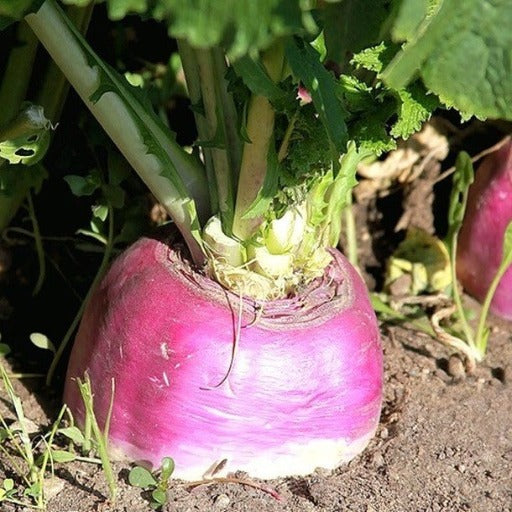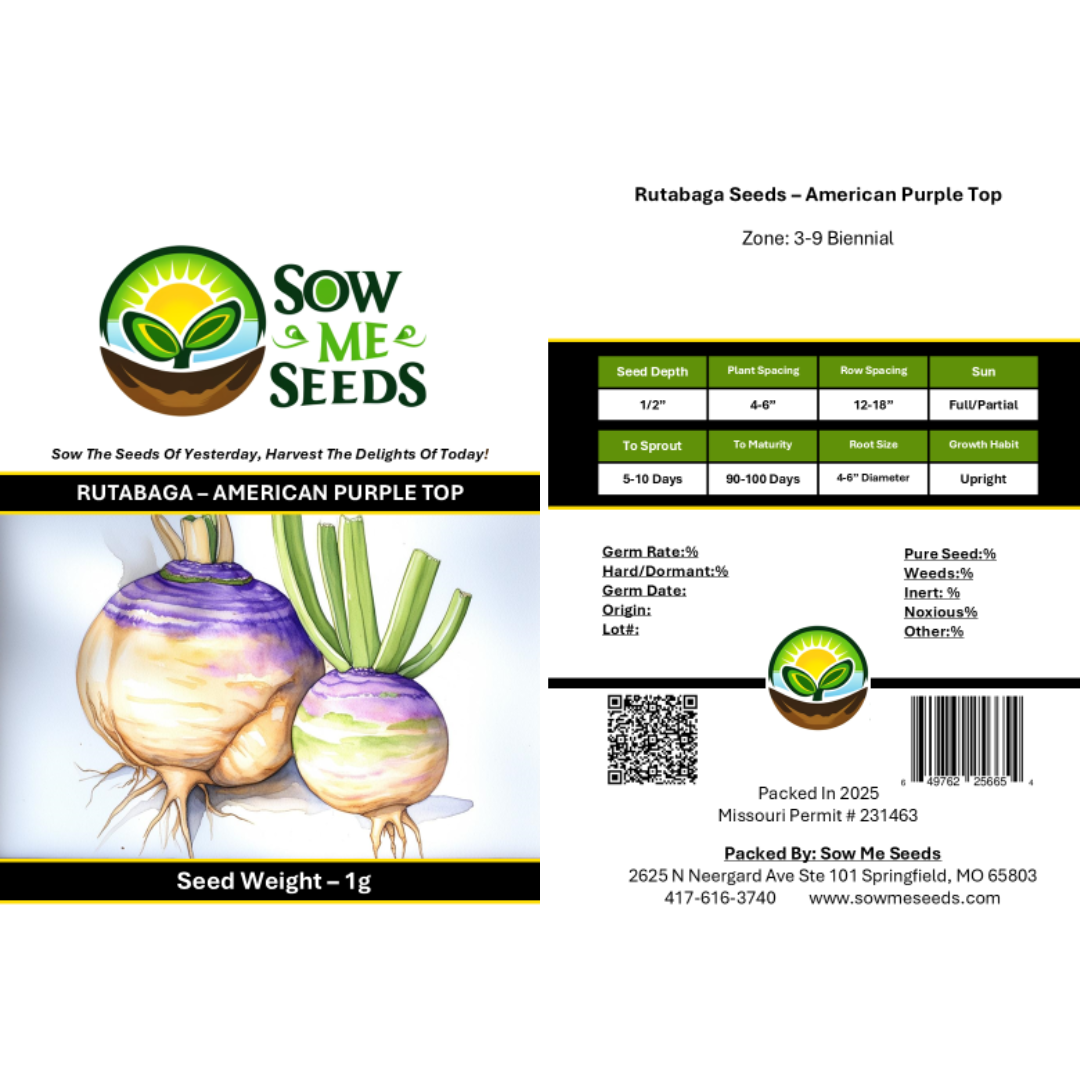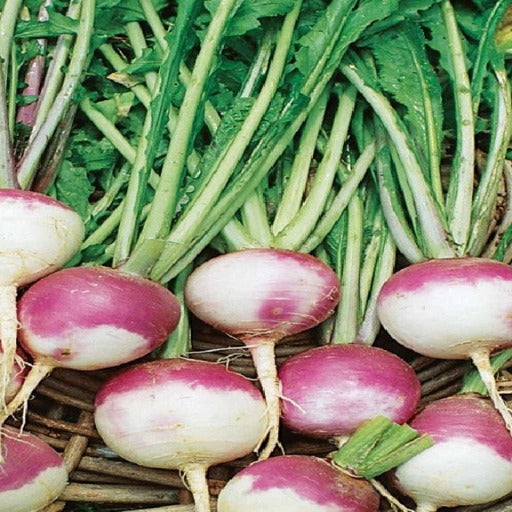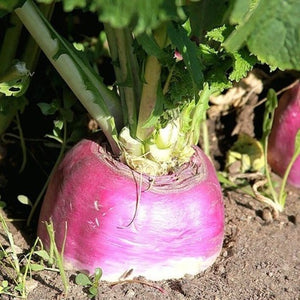- Hardiness Zone: 3-9 Biennial Typically Grown As An Annual
Seed Depth: 1/2 inch
Seed Spacing: 4–6 inches
Row Spacing: 18–24 inches
Sunlight: Full sun to partial shade
Days to Sprout: 5–10 days
Days to Maturity: 90–100 days
Growth Habit: Upright, bushy biennial (grown as an annual for roots)
Sunlight: Thrives in full sun but tolerates partial shade, especially in warmer climates.
Soil Type: Prefers well-drained, fertile soil with a pH of 6.0–7.5. Enrich soil with compost to support root development.
When to Plant: Sow seeds directly outdoors in early spring or late summer for a fall harvest. Rutabagas perform best in cooler temperatures.
Direct Sowing: Plant seeds 1/2 inch deep, spacing them 4–6 inches apart in rows 18–24 inches apart. Thin seedlings to proper spacing for optimal root development.
Indoor Sowing: Not typically recommended; rutabagas grow best when direct sown.
Succession Planting: Sow every 2–3 weeks for a staggered harvest during cooler months.
Watering: Water deeply and consistently, keeping the soil evenly moist but not waterlogged. Consistent moisture is essential for tender roots.
Fertilizing: Apply a balanced fertilizer or compost at planting and mid-season to encourage healthy roots and foliage. Avoid excessive nitrogen, which can promote leaf growth over root development.
Pruning: No pruning is necessary; greens can be harvested sparingly for culinary use while roots develop.
Pest and Disease Control: Monitor for flea beetles, aphids, and root maggots. Use row covers or organic treatments as needed.
When to Harvest: Harvest roots when they are 3–5 inches in diameter for the best flavor and texture, typically 90–100 days after planting.
How to Harvest: Loosen soil around the roots with a garden fork and gently pull them from the ground. Avoid damaging the roots during harvest.
Seed Collection: Allow some plants to overwinter and flower the following year. Collect seeds from mature pods once dry.
Storing Seeds: Store seeds in an airtight container in a cool, dry place.
Why You’ll Love It
Cold-Weather Champion: Grows best in fall and sweetens with light frost.
Distinct Appearance: Yellow roots with a vibrant purple top — easy to spot and harvest.
Sweet & Nutty Flavor: Mellow, buttery taste that shines in winter meals.
Long Storage Life: Keeps well in root cellars or refrigerators for months.
Plant Characteristics
Height: 12–18 inches
Growth Habit: Large, leafy tops with rounded root development above and below soil
Root Type: Round, yellow roots with purple shoulders
Days to Maturity: 90–100 days
Hardiness: Cool-season biennial grown as an annual
Flavor and Culinary Uses
Flavor: Mild, sweet, and nutty with a creamy texture when cooked
Culinary Uses: Great for roasting, mashing, soups, stews, and casseroles
Companion Planting Tips
Good Companions: Onions, garlic, peas, and herbs like mint
Avoid Planting Near: Other brassicas (to prevent pest buildup)
Bonus Benefit: Adds variety to the fall garden and stores well into winter
Common Issues and Solutions
Root Maggots or Cabbage Worms: Use floating row covers and rotate crops
Woody Texture: Harvest before over-maturity and avoid drought stress
Slow Growth: Ensure full sun and fertile, loose soil
Seeds Per Packet
| 1g | Approximately 424 |
| 3g | Approximately 1,272 |
Why You’ll Love It
Cold-Weather Champion: Grows best in fall and sweetens with light frost.
Distinct Appearance: Yellow roots with a vibrant purple top — easy to spot and harvest.
Sweet & Nutty Flavor: Mellow, buttery taste that shines in winter meals.
Long Storage Life: Keeps well in root cellars or refrigerators for months.
Plant Characteristics
Height: 12–18 inches
Growth Habit: Large, leafy tops with rounded root development above and below soil
Root Type: Round, yellow roots with purple shoulders
Days to Maturity: 90–100 days
Hardiness: Cool-season biennial grown as an annual
Flavor and Culinary Uses
Flavor: Mild, sweet, and nutty with a creamy texture when cooked
Culinary Uses: Great for roasting, mashing, soups, stews, and casseroles
Companion Planting Tips
Good Companions: Onions, garlic, peas, and herbs like mint
Avoid Planting Near: Other brassicas (to prevent pest buildup)
Bonus Benefit: Adds variety to the fall garden and stores well into winter
Common Issues and Solutions
Root Maggots or Cabbage Worms: Use floating row covers and rotate crops
Woody Texture: Harvest before over-maturity and avoid drought stress
Slow Growth: Ensure full sun and fertile, loose soil
Seeds Per Packet
| 1g | Approximately 424 |
| 3g | Approximately 1,272 |





Share and get 15% off!
Simply share this product on one of the following social networks and you will unlock 15% off!